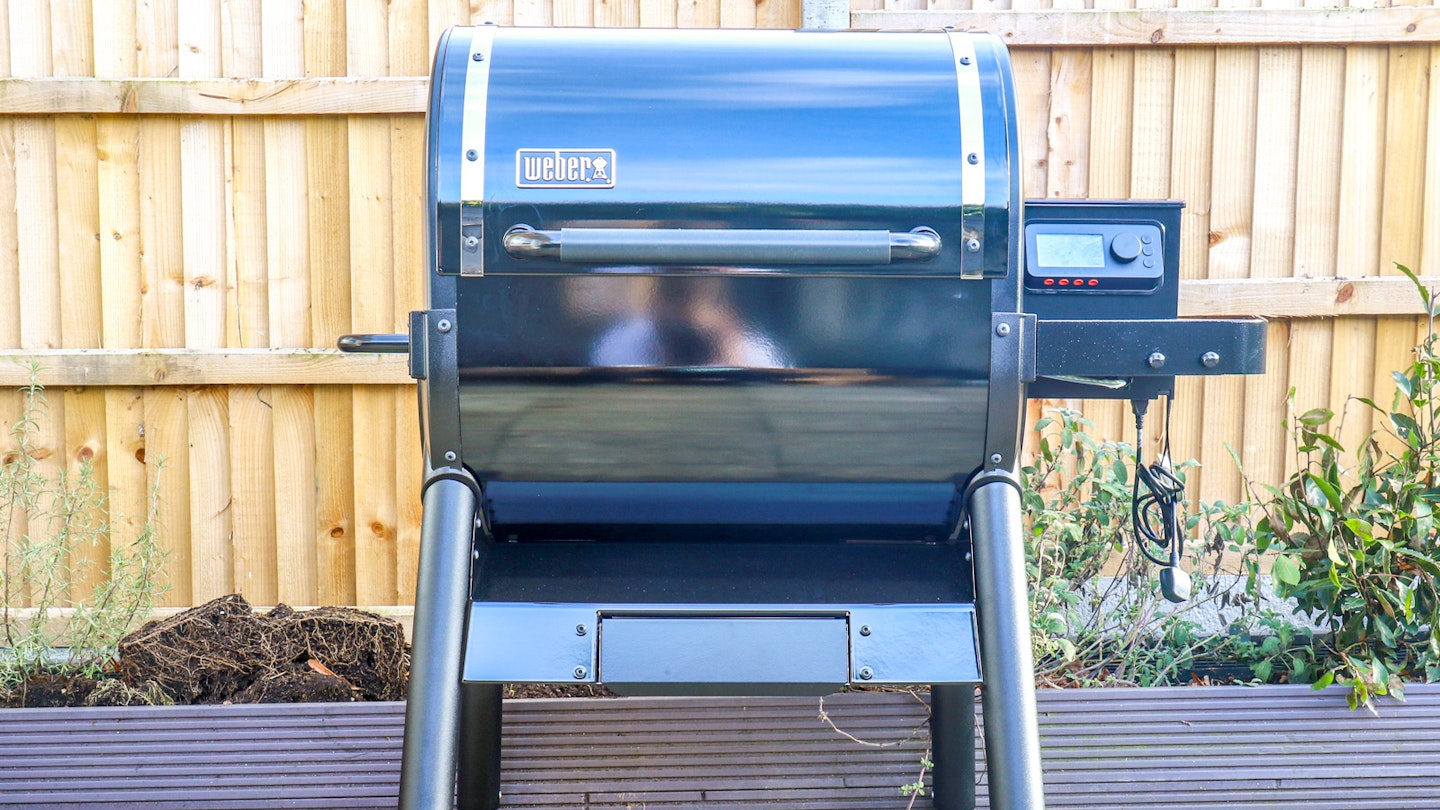Pellet grills like the SmokeFire EPX4 Stealth Edition combine the flavour of wood and charcoal smoke with the easy start-up and heat control of a gas barbecue grill. You set the temperature you want on the screen (ranging from super low-and-slow to searing heat), and then the grill maintains it by automatically adding more fuel from the hopper. Weber’s second-generation SmokeFire grill aims to improve some of the less-good elements of its predecessor and place this barbecue heavyweight at the top of the food chain.
Our resident BBQ enthusiast, Adam Binnie, put the Weber SmokeFire EPX4 Stealth Edition barbecue through its paces, comparing it to the earlier Weber model and testing everything from the pellet grilling performance to the stand-out smart features. For a barbecue that claims to do it all, did it stand up to the test?
Verdict score: 4.5/5
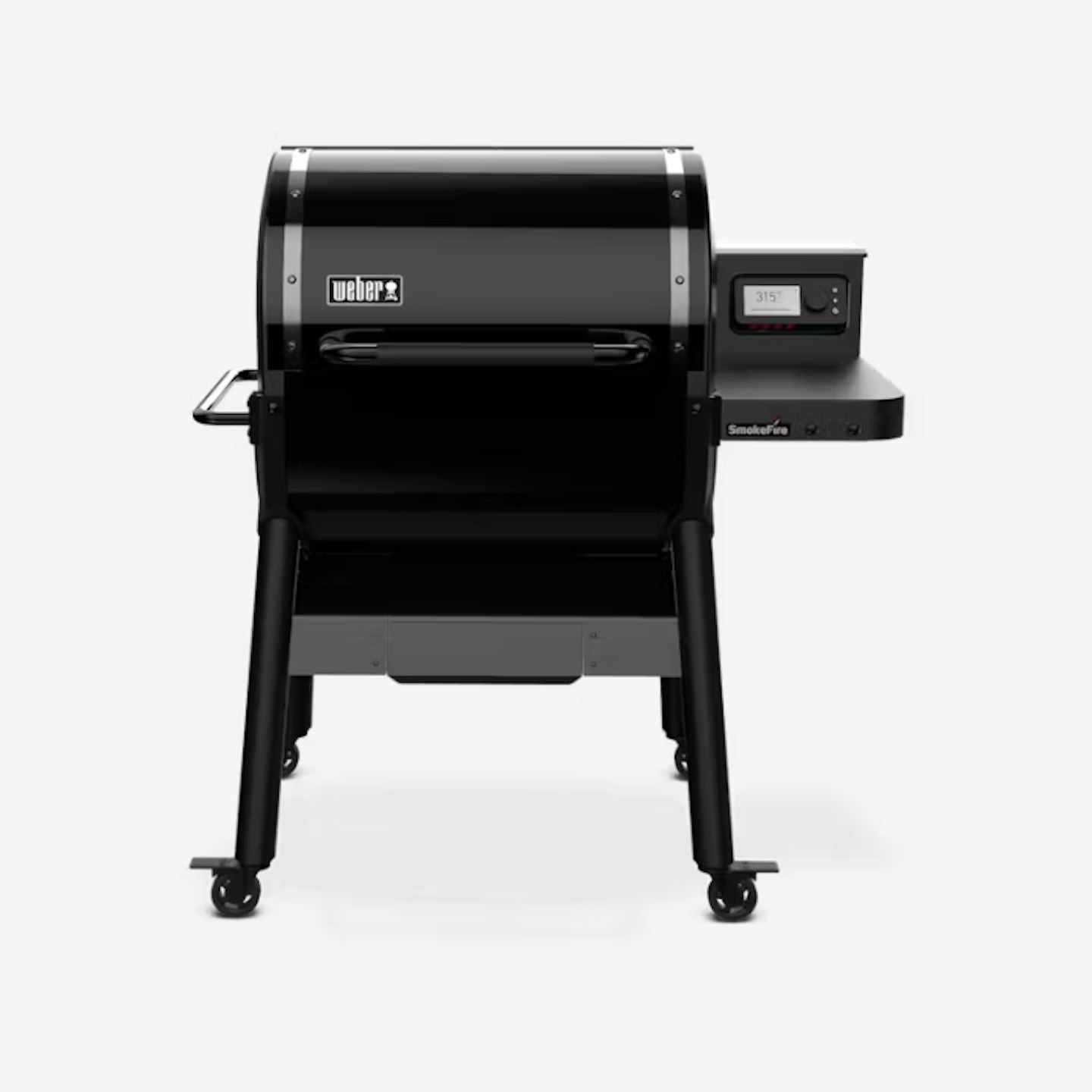
www.weber.com
Pros
- Stable, consistent and infinitely adjustable heat
- Imparts deep smoky flavour
- Big cooking capacity for 10+
Cons
- No cabinet storage
- Only one shelf
| Fuel type | Wood pellet |
| Temperature range | 95-315 |
| Dimensions | 119.38cm x 110.49cm x 83.82cm |
| Total cooking area | 4,270cm |
| Weight | 62.14kg |
The quick version
The Weber SmokeFire takes (almost) all of the guesswork out of barbecuing – with easy-to-maintain, consistent heat available from 95-315 degrees Celsius. You simply set the temperature you want and then let the grill get on with it, with no further faffing with vents or dials required, leaving you free to do something else.
Weber’s superb (and recently updated) Connect app and probe keep an eye on the barbecue and internal temperature of your food for you, so you can be confident whatever you’re cooking will be in the sweet spot between under and overdone. Everything I’ve cooked on it has been absolutely delicious and totally foolproof. The build quality is as peerless as you’d expect, and it looks superb in your garden too.
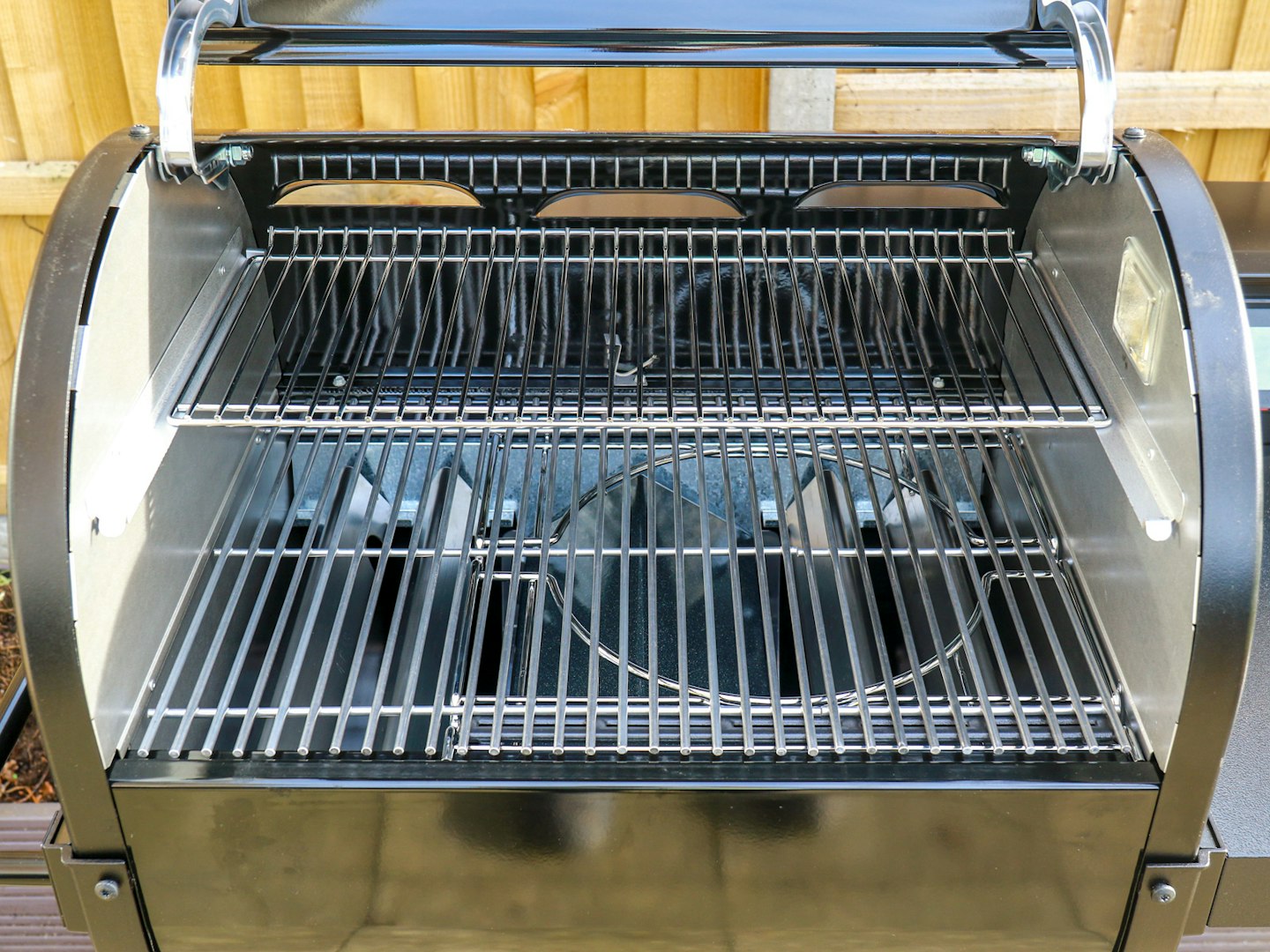
Downsides? It’s a bit noisy, pellets are still a bit trickier to find than charcoal or gas, and it can’t run without being plugged into the mains electricity. There is also the more existential question of whether this level of control takes away some of the satisfaction of outdoor cooking – but I’ll answer that in the full verdict below.
Jump to:
What’s new?
This second-generation SmokeFire addresses a few of the teething problems experienced in the first model. The ramp in the hopper is steeper to encourage the pellets to flow more easily, and the augur mechanism has been redesigned to avoid it getting jammed. I’ve yet to experience a jam (although the SmokeFire is capable of resolving the situation by itself anyway) and the pellets seem to move down the hopper quite well. I've had no issue with either, so it's fair to say the fix has worked.
Testing the SmokeFire EPX4 Stealth Edition barbecue
Build
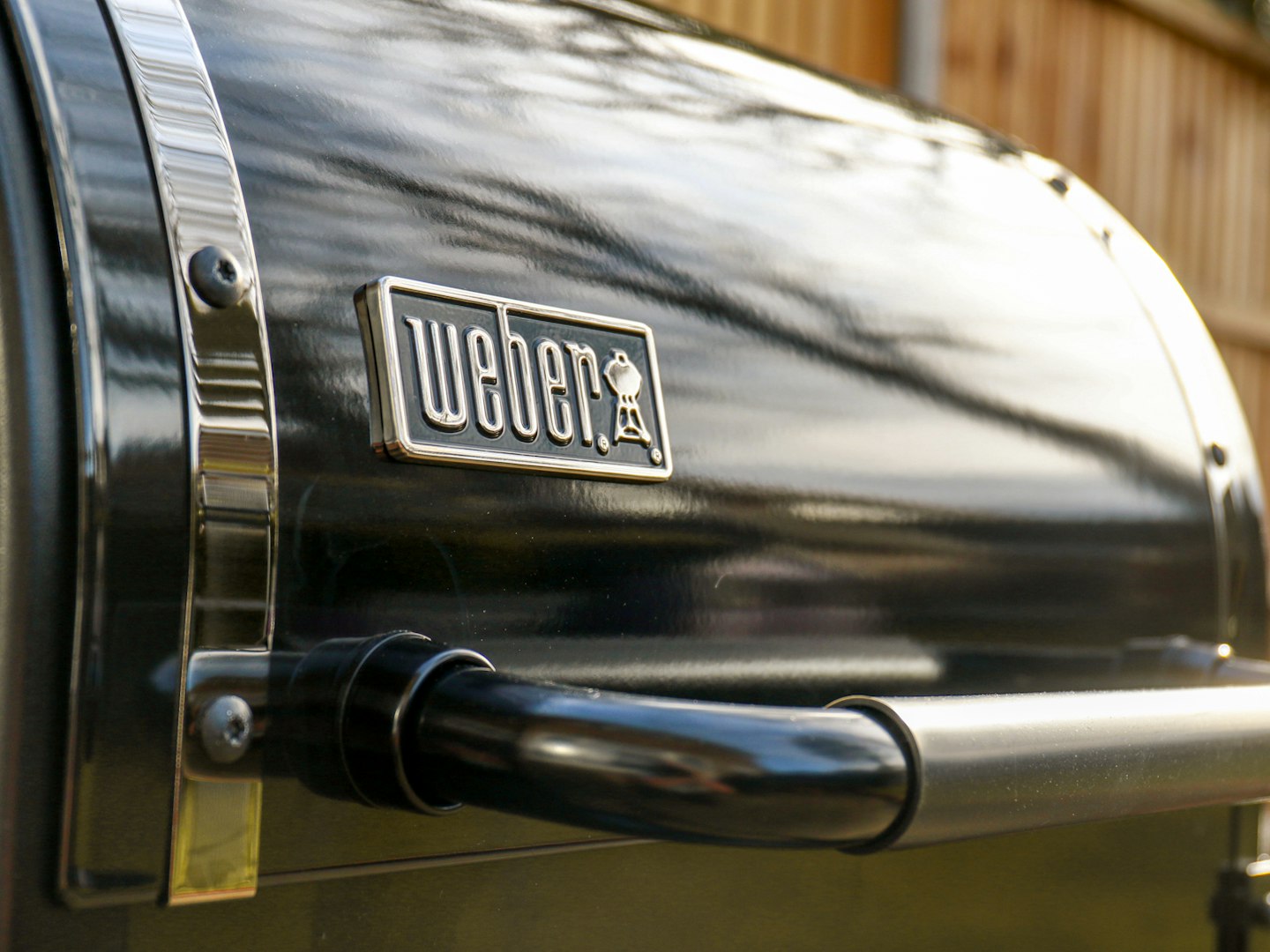
• Rock-solid construction
• Easy (but heavy) to assemble
• Control knob a bit lightweight
As with the Weber Genesis EPX-335 I reviewed, the SmokeFire arrived in a massive box on a wooden pallet and required construction before it could be used. This time around, I used the BILT app, which is like a three-dimensional instruction manual, and made the whole process a lot simpler.
It’s quite time-consuming but a simple enough process. I’d recommend getting a friend to help – there are some heavy parts to manoeuvre (the bottom of the cook box and pellet hopper arrive as one piece), and it’d be quite easy to damage them/yourself in the process.
Once assembled on its sturdy legs, things get easier, there’s a reasonably technical job involving the insertion of the glow plug (you get some spares in the box too), but you should be able to get it up and running in an afternoon, including the 'burn-in' process, which essentially just means putting it on full whack for half an hour.
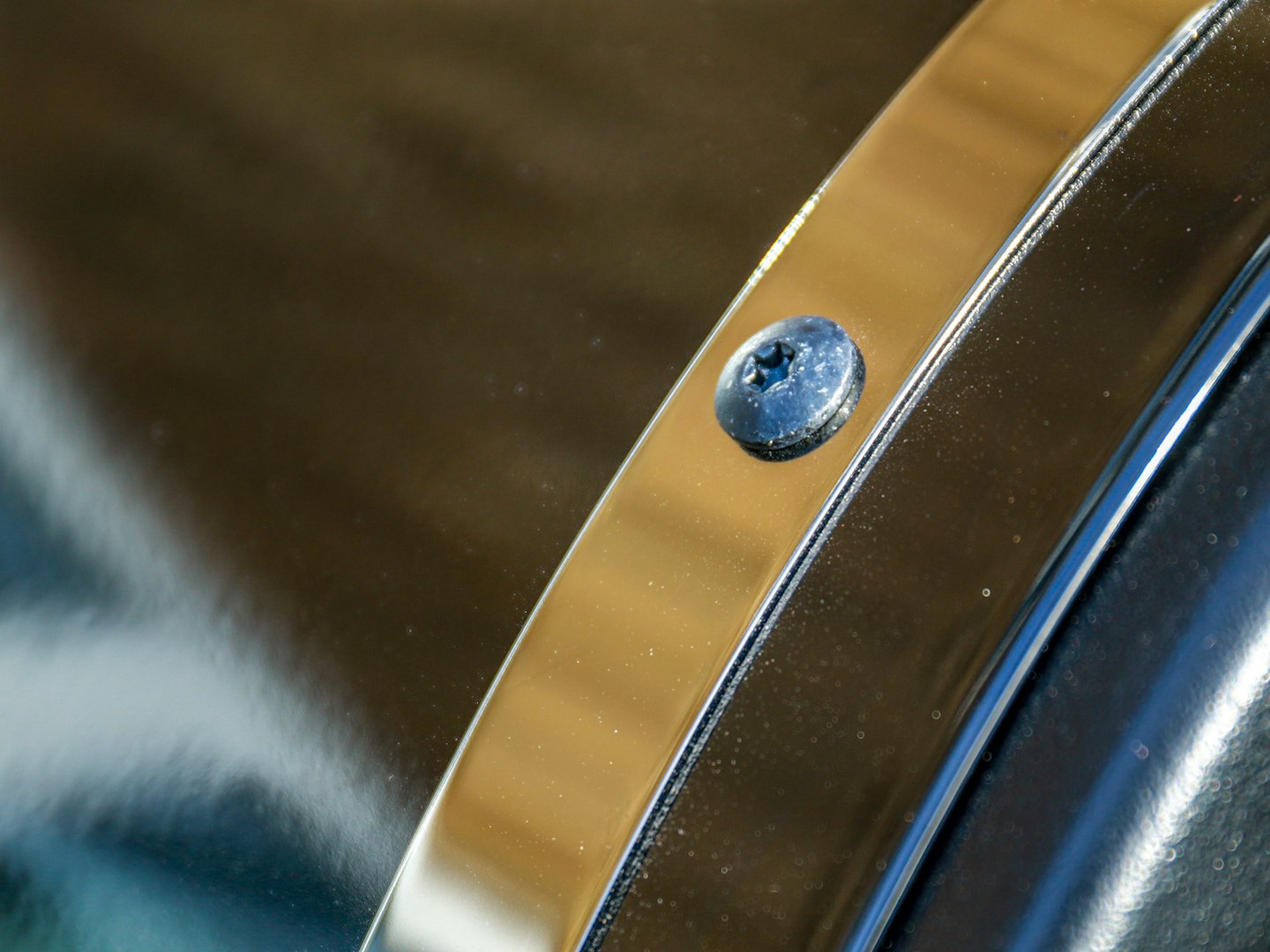
The Smokefire is an impressive item to behold, particularly in the 'Stealth' colour-scheme, which swaps out brighter chrome trim elements for darker ones. As with most Weber BBQs, it feels built to last, with a heavy lid and smooth castors to roll on. The screen is easy to see in direct sunlight and the shelf has stood up to several heavy joints of meat without a problem.
My only minor complaint is the main control knob, which is made of plastic and feels cheap in contrast to the heftier parts of the barbecue. Given how often you’ll be using it, I’d have preferred a metal version or even just a rubberised grip.
Usability
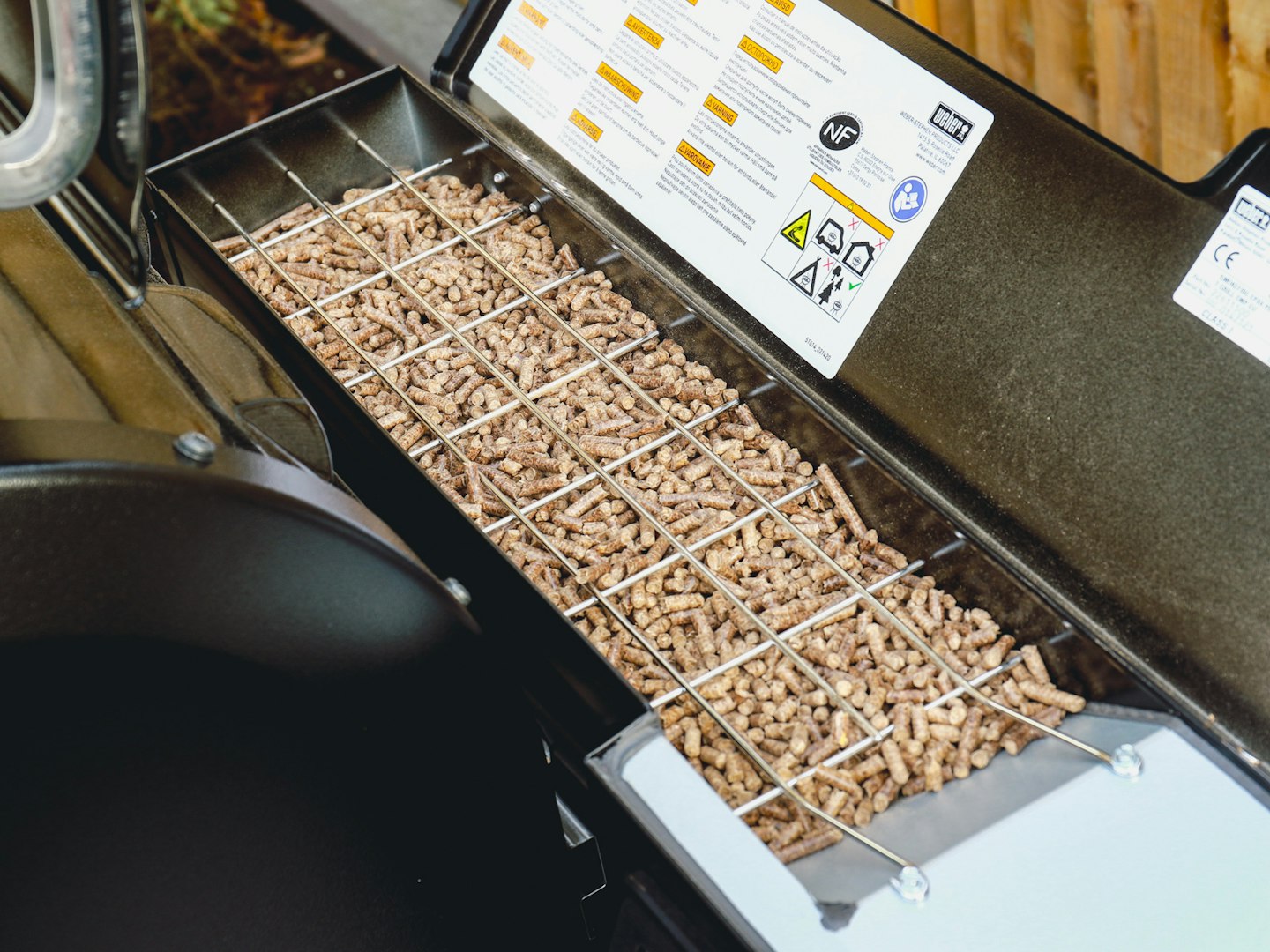
• Large hopper holds 9kg of pellets
• Smart barbecue features are easy to use
• A second shelf would be useful
If you’re used to using a standard charcoal grill, the SmokeFire will seem like cheating. Simply fill the hopper with pellets, select the temperature you want on the control screen (or app), and walk away. It is just like using an oven really.
Side-by-side with my Weber Genesis gas grill, there are some key usability differences, which I’m not sure I’d be bothered about in insolation. Namely, you only get one shelf (a second is available as an option, but the Genesis has two) and there is no cabinet to store anything in. The latter is less of an issue because there’s no gas bottle to hide away, but I’d prefer to keep my container of pellets with the barbecue rather than in the shed.
I’ve also struggled a couple of times when emptying the pellet hopper – if you finish cooking and still have fuel left inside (it takes a 9kg bag with ease), you can pull a handle to release the excess into a box to keep it safe and dry for next time. No matter where I position the container, a small number of pellets end up on my patio. Not a deal breaker, but a bit annoying.

In terms of ergonomics, the numbers on the screen go up slower than the control knob turns, so you sometimes find yourself winding it round and round to only increase the temperature a little bit. I’ve avoided this issue entirely by handing over control of the SmokeFire to my phone.
What smart features does the Weber SmokeFire have?
Space for four probes and the ability to communicate with your phone via Bluetooth (over short distances) or WiFi (over longer ones). This is where the barbecue really comes into its own, because you can remotely monitor the internal temperature of your ingredients, and the cooking temp itself, without needing to be stood next to it.
The app has recently been updated and it’s a huge improvement, particularly in how it tracks temperature data. The most useful upgrade for me is the addition of a graph view for your probes, with temperature up the side axis and time along the bottom. With this, you can accurately see when a pulled pork has hit the 'stall' for example, and how long it’s been sitting there.
Compare this with my previous smoker grill set-up – lighting a daisy chain of briquettes in my Kettle grill – and the reduction in guesswork and manual input is enormous. Doing it this way requires fiddling with the barbecue vents every half an hour to maintain the right temperature and losing all the heat every time you open the lid to temp probe whatever you’re cooking, or when adding more fuel.
Don’t get me wrong, I appreciate the appeal of sitting out in the garden all day while a brisket smokes away, but the SmokeFire opens up all sorts of possibilities to create delicious low and slow food without being tied to a barbecue for 12 hours. It’s a nice option to have.
Performance
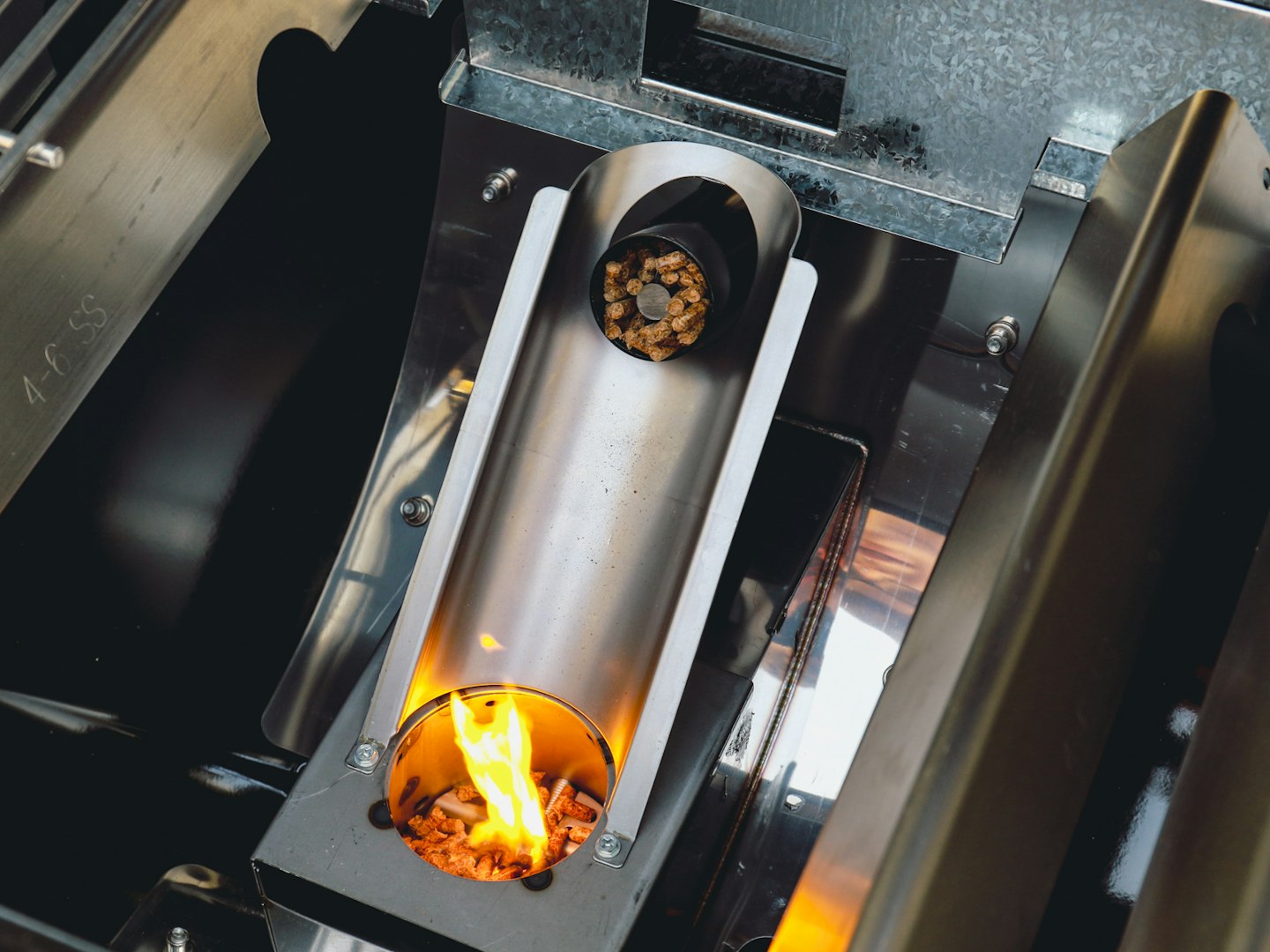
• As easy to use as an oven
• Self-igniting, thermostatic temperature
• Easily cater for 10+ with big meat joints
Unlike a charcoal grill, the heat source is insulated from the underside of the food, so there is no risk of burns from fat flare-ups. Best of all, using wood as a fuel imparts a deep and complex smoky flavour that you simply don’t get from a gas barbecue. It really is the best of both worlds.
I’ve cooked all sorts on the SmokeFire to test the claim that it is all the barbecue you need - not just useful for low and slow smoking – but hot enough to sear steaks. The only limiting factor here is the shape of the grill bars, which are round and thinner than the wide, flat bars on my gas grill, so they don’t leave as impressive a mark.
There’s a good reason for this because it means more ingredient surface area for smoke to adhere to, and so they're a fair compromise. Using a 'reverse sear' technique (where you cook things at a low smoky temperature before dialling the heat up to scorch the outside) has brought a new depth of flavour to normally quick-cooking items like burgers and sausages. Plus, with the Gourmet Barbecue System range of accessories, you could always add a larger cast iron sear grate anyway.
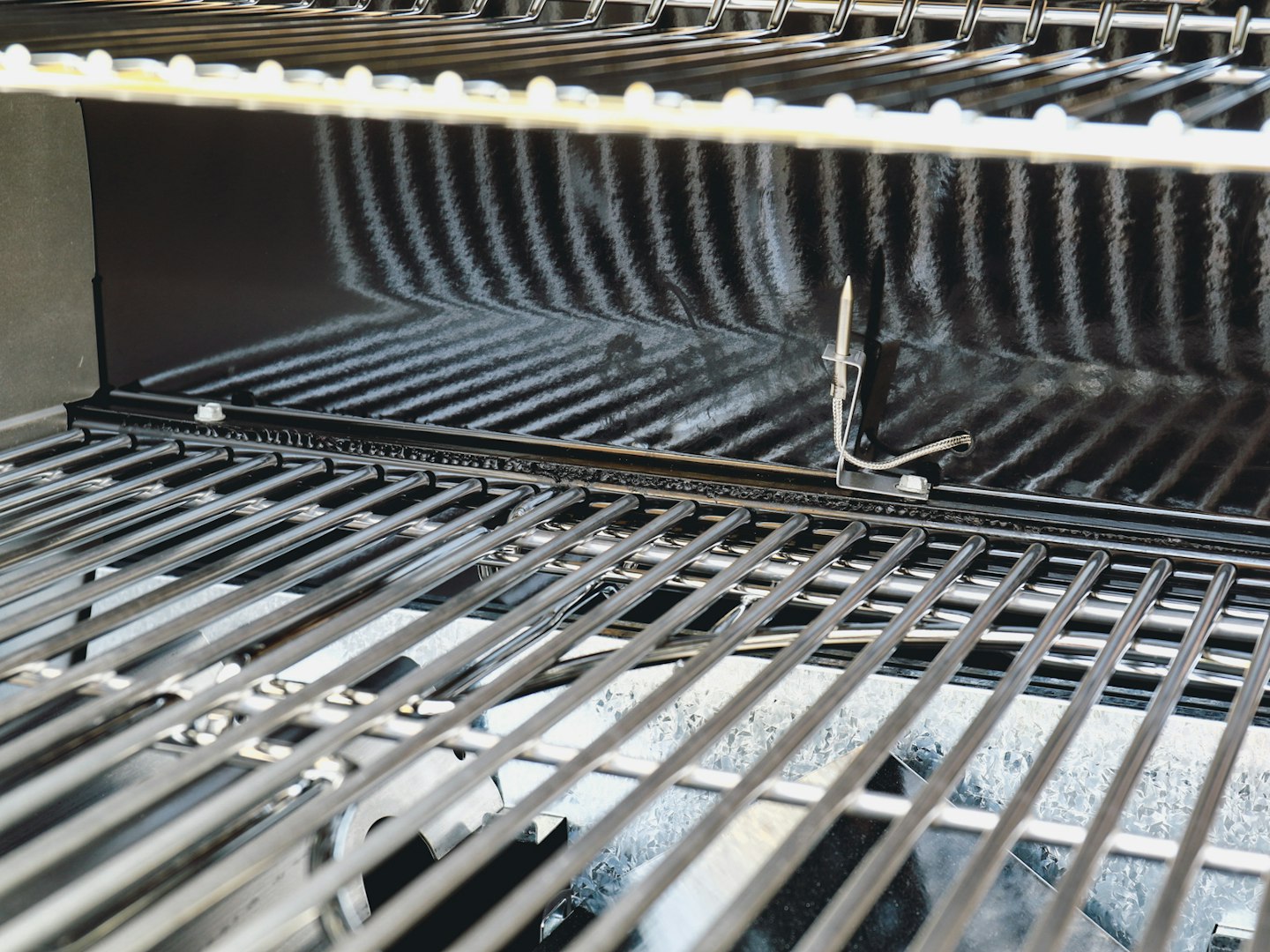
The SmokeFire takes about ten minutes to come up to temperature for smoking things like pork shoulder, turkey or brisket, and about 15 minutes if you want a high heat. There’s a special Smoke Boost setting, which limits the temperature to super-low while increasing the amount of smoulder from the pellets, and this is perfect for imparting even more flavour at the start of a long cook.
At the other end of the cook, you need to leave it plugged in for 10-20 minutes so it can complete its shut-down procedure. This can be a bit noisy, with the fan coming on and off at intervals to ensure all the fuel has been put out. You’ll also hear the fan at regular points during the cook too, particularly after opening the lid. It’s not intrusively loud, but it is a noise you won’t be used to hearing from a gas or charcoal grill.
How many people can the Weber Genesis cook for?
The EPX4 is the smaller of the two Smokefire grills that Weber makes and I’ve used it to comfortably cook for ten people. The cooking spaces are 61cm wide, with the smaller top grate measuring 19cm deep and the bottom one just over twice as deep at 45.5cm. it’s worth bearing in mind if you are using the top grate, it’s a bit harder to reach things at the back of the bottom one, but overall there’s a huge amount of space.
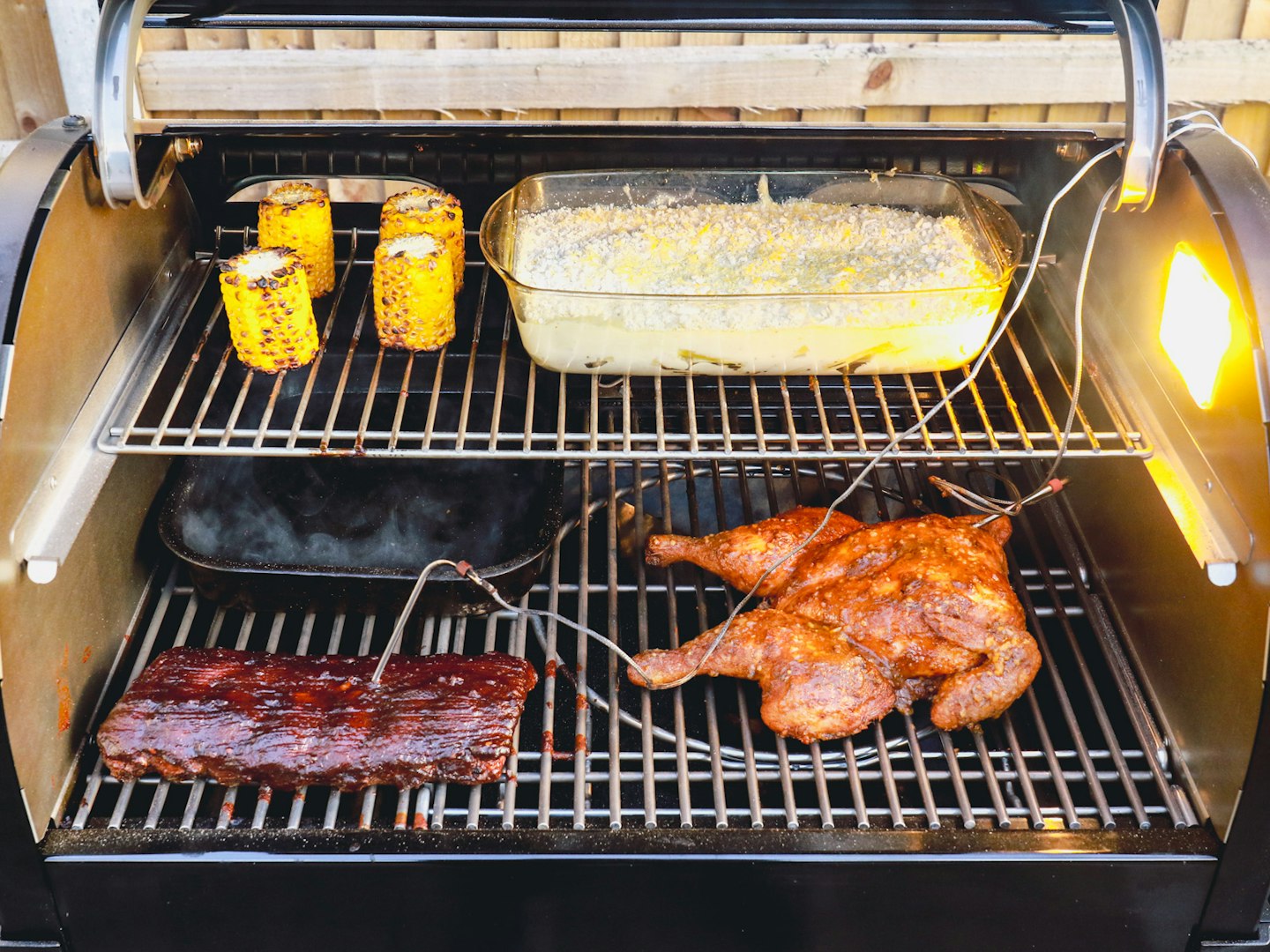
If you’re cooking low and slow, the most cost-efficient way is to put multiple items on at the same time. Running the SmokeFire for 12 hours or more is likely to burn through a whole bag of pellets (£15-£20 at the time of writing – and there’s a sensor in the hopper to alert you when you’re running low), so if you can do two or three things at once and then freeze or save them for later, it brings the overall cost of each item down. Or, find ways to sneak in other things you happen to be cooking at the time, like the shakshuka I made for breakfast while a pork shoulder was smoking or a huge mac and cheese.
I like recipes that call for a five to six-hour cook because you can create a superb smoky flavour in that time without using too many pellets. This includes things like whole turkey breast, baby back ribs, and beef short ribs, which you can put on early in the morning and then have for late lunch. Sliced and served with some hastily grilled burgers, you can absolutely fill a patio table with delicious things for a big party of adults.
What’s the Weber SmokeFire like to clean?
Pretty similar to a charcoal grill in that the main cookbox and grates can be cleaned by getting the barbecue really hot and then giving them all a good scrape. It's worth giving everything a more thorough scrub with a dedicated barbecue cleaning product every now and again, though.
Any fat or oil from whatever you’re cooking drips down into the bottom of the box, in theory, directed by channels into a disposable tray underneath. Ash from the consumed pellets also gathers in this area, and it’s important to regularly usher this into the collector below, otherwise, you end up with a potentially flammable fatberg blockage.
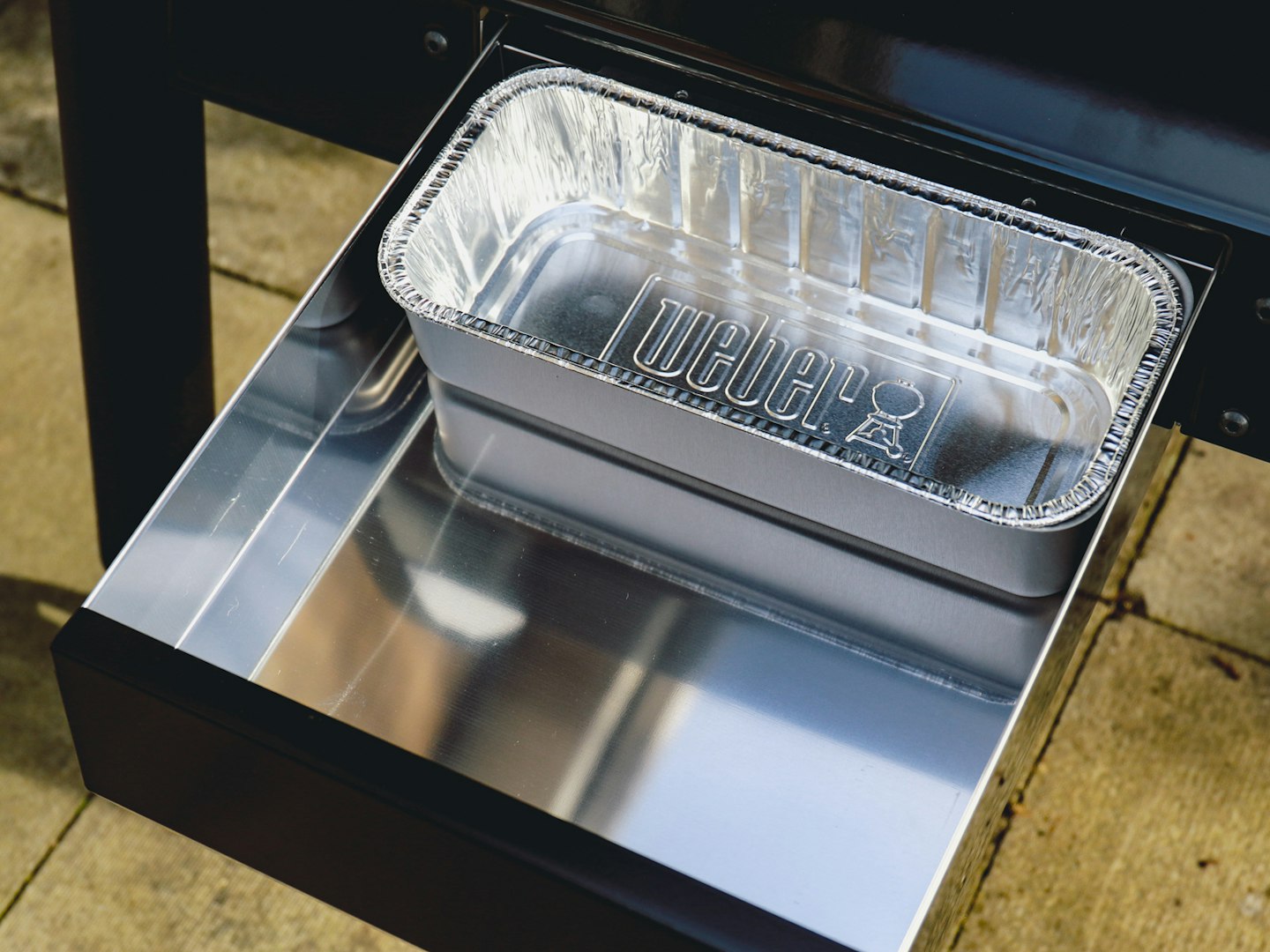
In my experience, the fat and grease tend to collect in this disposable tray while the ash dust finds its way separately into the drawer itself, which makes cleaning it out a bit easier.
Price and competition
There’s no getting away from the financial outlay the SmokeFire represents, which is over and above what you’d need to budget for a basic smoker, charcoal barbecue, or gas grill. But it’s important to remember that it does a pretty good impression of all three in one package, so there’s a sort of value-for-money argument if you really want to see it.
In terms of running costs, I’ve certainly spent more on pellets this year than charcoal or gas (probably combined) but it’s worth bearing in mind the SmokeFire is usually left running for 6-12 hours at a time, so it’s bound to use more fuel than my gas grill, which gets fired up for usually 30 minutes tops.
I like the Weber pellets as they seem to be the most consistent I’ve tried. They’re not as easy to get hold of as a bag of briquettes from the 24-hour garage. That said, propane gas wasn’t exactly abundant in 2022 when I ran out in the middle of summer either.
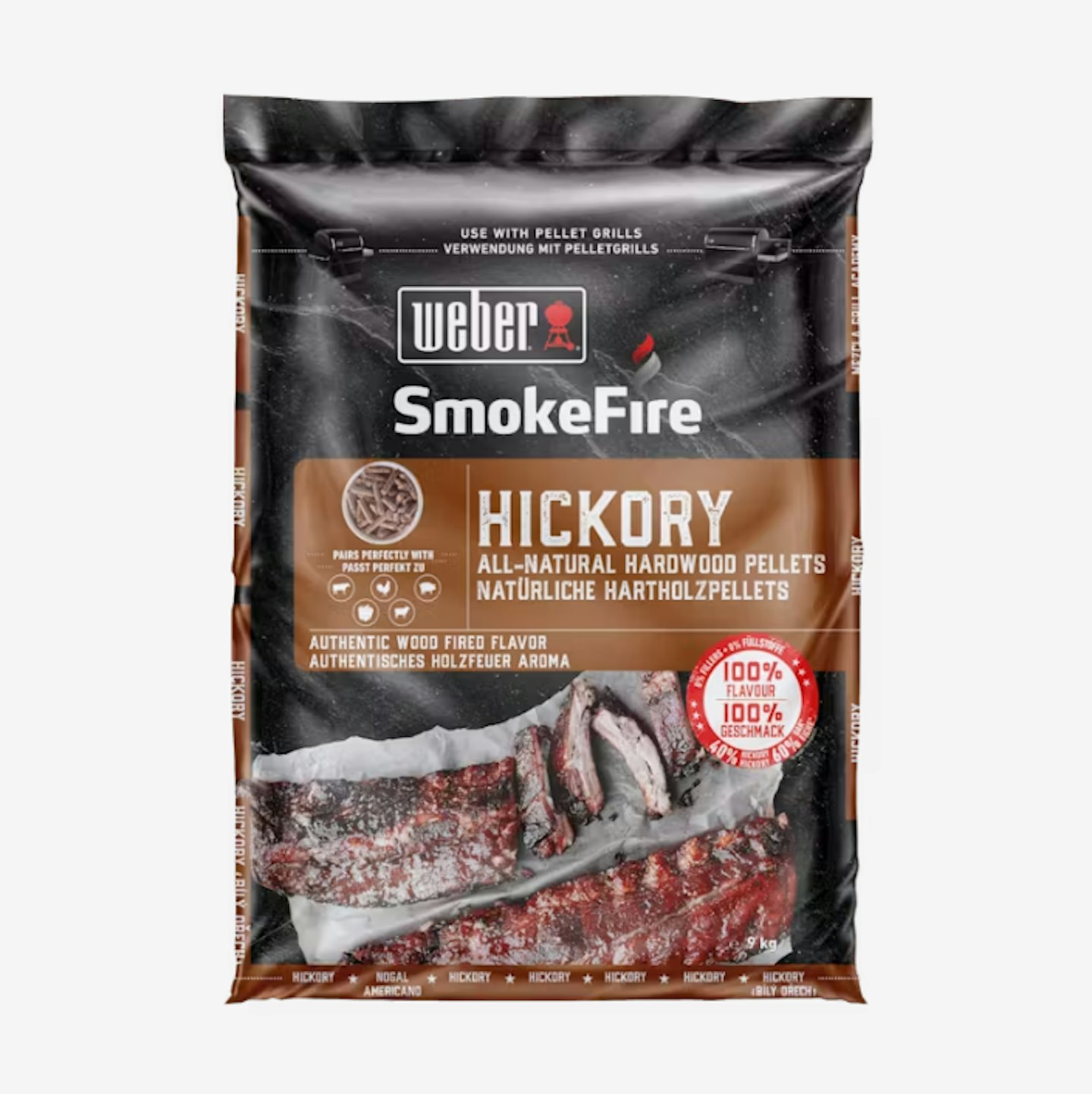
www.weber.com
In terms of competition, the Weber’s closest rival would be something from the higher end of the Traeger range like an Ironwood 650, which looks very similar in terms of size and spec. Traeger grills use a different heat dissipation method (basically a big sheet of metal between the flame and the food) which some people prefer as it keeps any grease and the pellet ash separate.
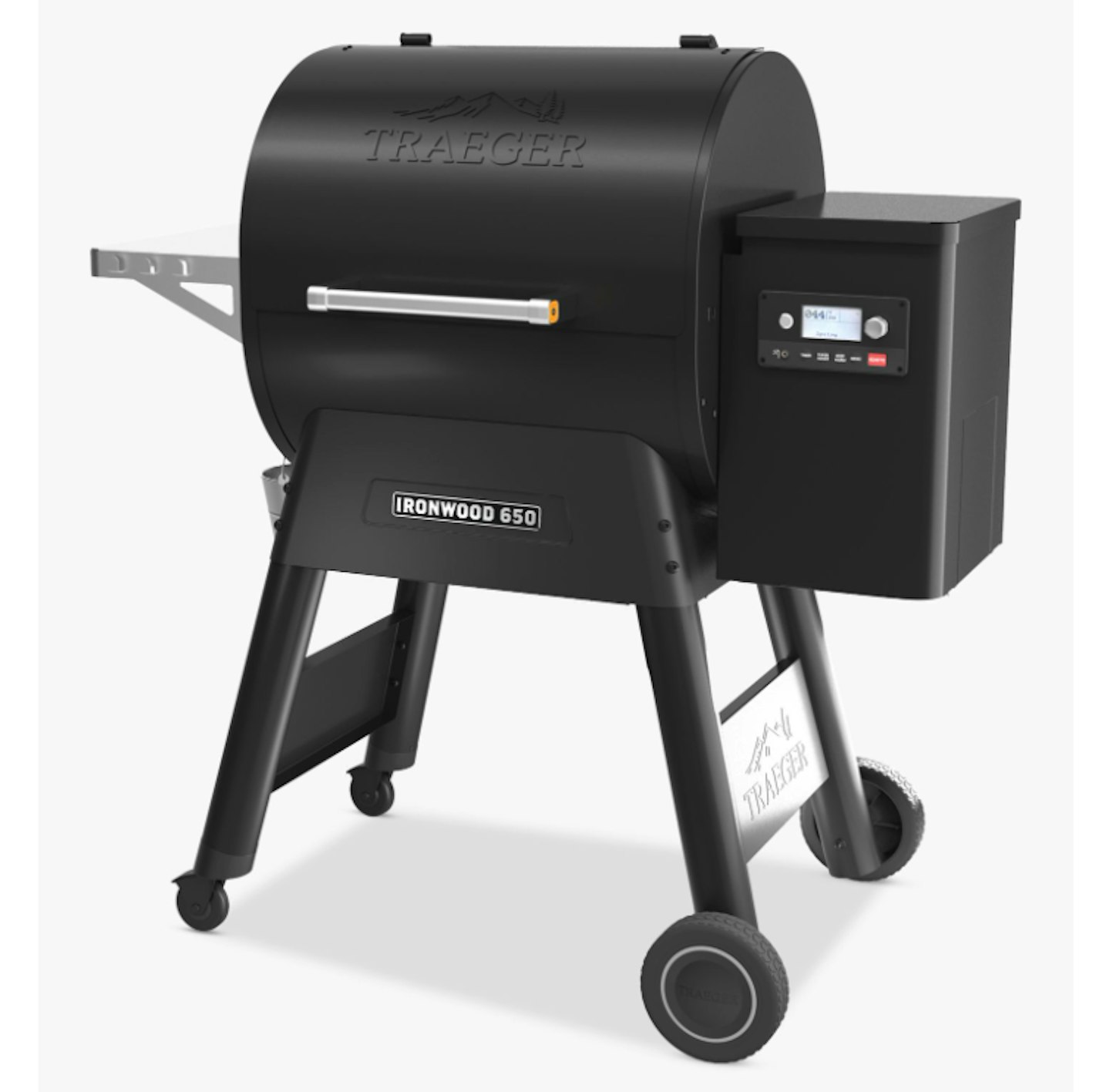
www.johnlewis.com
But then we've also reviewed a Ninja Woodfire grill that represents an interesting alternative - a fraction of the cost but capable of imparting a smoky flavour into smaller cuts of meat. Definitely worth a look unless you're after something that can run for several hours of smoking at a time.
Verdict
Pellet grilling is a very different sort of barbecue experience, but with that consideration to one side for one moment, the Weber SmokeFire (operationally at least) is faultless. So why doesn’t it get full marks?
I’d like an additional shelf, there’s no storage cupboard, and the fan can be a bit loud. Otherwise, this grill is incredibly versatile and is an extremely easy recommendation.
Verdict score: 4.5/5

www.weber.com
Pros
- Stable, consistent and infinitely adjustable heat
- Imparts deep smoky flavour
- Big cooking capacity for 10+
Cons
- No cabinet storage
- Only one shelf
| Fuel type | Wood pellet |
| Temperature range | 95-315 |
| Dimensions | 119.38cm x 110.49cm x 83.82cm |
| Total cooking area | 4,270cm |
| Weight | 62.14kg |
Who tested it?
Adam Binnie is a backyard cooking fanatic who is forever experimenting with new recipes or fettling old ones. He’s always enjoyed barbecuing but found a new obsession in American-style low-and-slow smoking after a trip to the famous Franklin Barbecue in Austin, Texas (which involved queuing up for four hours before eating).
He’s tried and tested all sorts of al fresco equipment from charcoal to gas and pellet, and knows exactly what features can make or break a barbecue.
How the product was tested
The Weber SmokeFire was tested in my garden in all weathers during the first six months of 2023 using Weber's own hickory pellets. I have cooked everything from small and quick cuts like burgers and vegetables, up to more committed low and slow joints like pulled pork, brisket and beef prime rib.
What to read next:
Discover everything you need to know to make your outside space look fantastic, quickly and easily, with hundreds of simple ideas, designer tricks, affordable products and expert advice with a Modern Gardens Membership. Find out more about the benefits of being a Member now.
Adam Binnie is the Affiliate Operations Editor and reviewer, specialising in bikes, fitness, cars, parenting and cooking.
